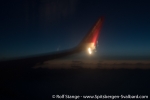-
current
recommendations- Liefdefjord
New page dedicated to one of Spitsbergen's most beautiful fjords. Background information and many photos.
- New Spitsbergen guidebook
The new edition of my Spitsbergen guidebook is out and available now!
- Liefdefjord
New page dedicated to one of Spitsbergen's most beautiful fjords. Background information and many photos.
Page Structure
-
Spitsbergen-News
- Select Month
- June 2025
- May 2025
- April 2025
- March 2025
- February 2025
- January 2025
- December 2024
- November 2024
- October 2024
- September 2024
- August 2024
- July 2024
- June 2024
- May 2024
- April 2024
- March 2024
- February 2024
- January 2024
- December 2023
- November 2023
- October 2023
- September 2023
- August 2023
- July 2023
- June 2023
- May 2023
- April 2023
- March 2023
- February 2023
- January 2023
- December 2022
- November 2022
- October 2022
- September 2022
- August 2022
- July 2022
- June 2022
- May 2022
- April 2022
- March 2022
- February 2022
- January 2022
- December 2021
- November 2021
- October 2021
- September 2021
- August 2021
- July 2021
- June 2021
- May 2021
- April 2021
- March 2021
- February 2021
- January 2021
- December 2020
- November 2020
- October 2020
- September 2020
- August 2020
- July 2020
- June 2020
- May 2020
- April 2020
- March 2020
- February 2020
- January 2020
- December 2019
- November 2019
- October 2019
- September 2019
- August 2019
- July 2019
- June 2019
- May 2019
- April 2019
- March 2019
- February 2019
- January 2019
- December 2018
- November 2018
- October 2018
- September 2018
- August 2018
- July 2018
- June 2018
- May 2018
- April 2018
- March 2018
- February 2018
- January 2018
- December 2017
- November 2017
- October 2017
- September 2017
- August 2017
- July 2017
- June 2017
- May 2017
- April 2017
- March 2017
- February 2017
- January 2017
- December 2016
- November 2016
- October 2016
- September 2016
- August 2016
- July 2016
- June 2016
- May 2016
- April 2016
- March 2016
- February 2016
- January 2016
- December 2015
- November 2015
- October 2015
- September 2015
- August 2015
- July 2015
- June 2015
- May 2015
- April 2015
- March 2015
- February 2015
- January 2015
- December 2014
- November 2014
- October 2014
- September 2014
- August 2014
- July 2014
- June 2014
- May 2014
- April 2014
- March 2014
- February 2014
- January 2014
- December 2013
- November 2013
- October 2013
- September 2013
- August 2013
- July 2013
- June 2013
- May 2013
- April 2013
- March 2013
- February 2013
- January 2013
- December 2012
- November 2012
- October 2012
- September 2012
- August 2012
- July 2012
- June 2012
- May 2012
- April 2012
- March 2012
- February 2012
- January 2012
- December 2011
- November 2011
- October 2011
- September 2011
- August 2011
- May 2011
- April 2011
- March 2011
- February 2011
- January 2011
- December 2010
- November 2010
- September 2010
- August 2010
- July 2010
- June 2010
- May 2010
- April 2010
- March 2010
- February 2010
- November 2009
- October 2009
- August 2009
- July 2009
- June 2009
- May 2009
- April 2009
- March 2009
- February 2009
- January 2009
- December 2008
- November 2008
- October 2008
- August 2008
- July 2008
- June 2008
- May 2008
- April 2008
- March 2008
- February 2008
- April 2000
- Select Month
-
weather information
-
Newsletter

| Guidebook: Spitsbergen-Svalbard |
Home
→ January, 2019
Monthly Archives: January 2019 − News & Stories
Polarjazz Festival 2019 opened with “Vorspiel”
Some may still think of Longyearbyen as a small, remote and dusty mining settlement at the cold end of the world, but the times when this was actually the case have been history now for decades. Today, Longyearbyen is very much an alive and culturally active place with an international population and atmosphere.

The Store Norske Mannskor, here seen at the “Vorspiel” of the Polarjazz Festival 2019, is one of Longyearbyen’s most popular musical acts.
The local culture scene is home to an impressive number of choirs and other music groups. This is the fertile ground where several music festivals were born, some of which have made it into the calendars of international fans. Next to the Dark Season Blues Festival, which happens in early October, there is the Polarjazz Festival going on under the motto “Cool Place Hot Music”. The opener is the so-called “Vorspiel”, which happened Wednesday (30.01.) evening in the Kulturhuset (culture hall) in Longyearbyen. An impressive number of local acts took the scene, from young, fresh talents through the popular Store Norske Mannskor to well-established artists like the local singing bird Liv Mari Schei who has a record catalogue of several CDs.
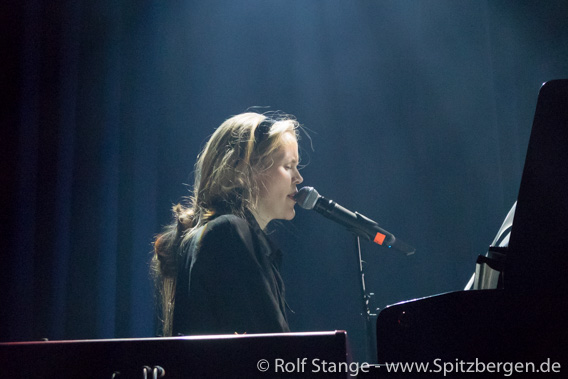
Liv Mari Schei: well-known singing bird in and from Longyearbyen.
Advance ticket sales were behind execptations, but at least at the “Vorspiel” there were about as many in the audience as would have found space. People were sitting on stairs or wherever there was space.
Well-established artists from Norway will take Longyearbyen’s various scenes during the next days.
Northern lights, northern lights, northern lights …
Sat
26 Jan
2019
My dear friends, let me tell you, it is tough. For weeks we have been trying to get some sleep at normal times. But it just doesn’t work. This northern light is really too bad. Really, it can be annoying! You always have to go out, watch Lady Aurora dancing, take photos … yes, life in the Arctic can be hard … 🙂

Northern light aureola, near-vertically above the photographer’s position.
It was almost warm today, just about -6°C in Adventdalen. In comparison to the last days, it felt really mild. Only the wind was a bit chilly.

Ring of northern lights over Endalen.
I can’t promise that there won’t be any more aurora borealis pics in this blog during the next weeks. This is how the polar night is. On the other hand, Lady Aurora can be very moody. Sometimes she is just sleeping somewhere far away or she is just dancing for the clouds. When she is in good mood then you just have have to take the opportunity. You never know when the next one comes – maybe this is her farewell for the moment and she decides to move on to another planet or wherever.
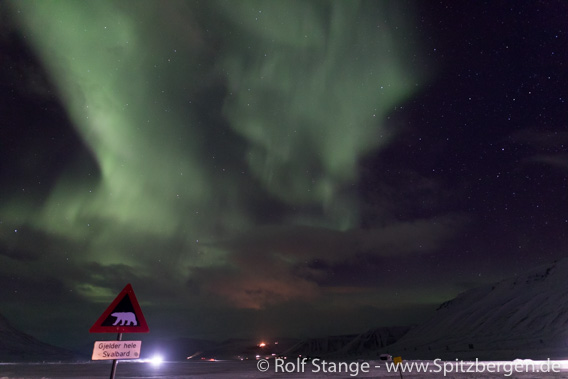
The famous polar bear warning sign.
Blue lights and northern lights
Fri
25 Jan
2019
The days are just flying, or rather this endless night. It will still take a while until you can talk of “days” again in Spitsbergen. But the light is coming back! There is clearly some faint dawn on the southern horizon around noon. The sun is not far anymore.
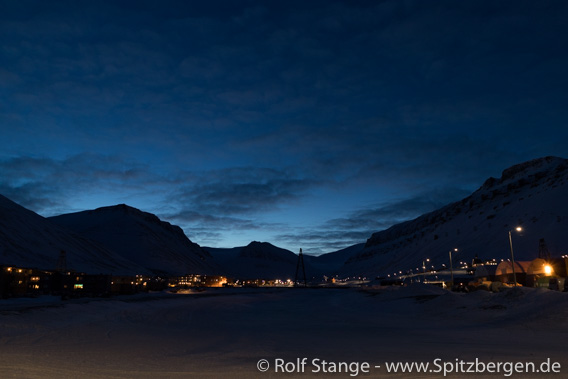
First dawning in late January, mid-day in Longyearbyen.
Still, the polar night is obviously a good time to do things inside. And there is no lack of good opportunities. Next to all the work that never takes an end, there is, just to give one example, the already mentioned Svalbarseminar. And for Per Kyrre Reymert, the “cultural heritage oracle”, the same is true as for Maarten Loonen (see previous blog): you are guaranteed to get a solid portion of interesting arctic knowledge, and it is fun to listen to! A very entertaining hour where you can only try to memorise as much as you possibly can. Today, it was about the French Recherche-expedition (1838, 1839). Yes, that was the one with Leonie D’Aunet, the first woman who visited Spitsbergen. As far as we know, that is.
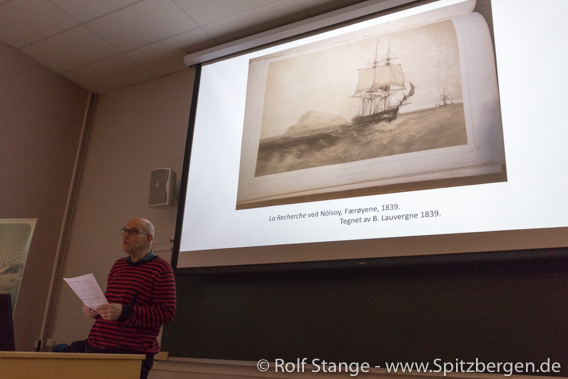
Per Kyrre Reymert speaking in the Svalbardseminar at UNIS about the Recherche-expedition (in Spitsbergen 1838 and 1839).
And it is certainly good to know what the guys from the Sysselmannen (government representative, police and other sovereign duties) are keeping themselves busy with. Flying drones, for example. Of course they are only doing sensible things with these drones! Who would thing of anything different … Police investigations, search and rescue operations, documenting erosion and wear and tear on cultural heritage sites … the list is long.

The “drone-squadron” of the Sysselmannen presenting their work in the Svalbardseminar at UNIS.
It is and remains stunningly beautiful outside. The light of the moon is now less bright than last week, but the returning sun – still well below the horizon – brings several hours of blue light into the darkness during daytime.
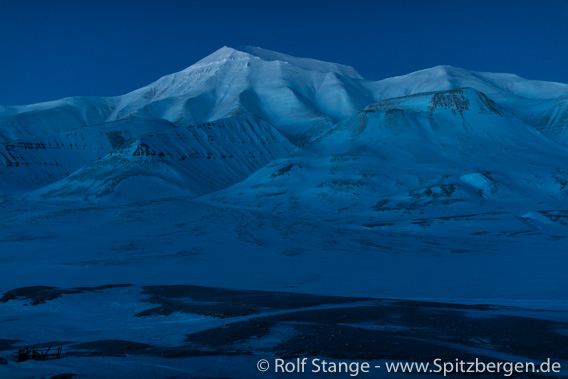
The blue light hours are coming back to Spitsbergen during daytime.
A little trip into Adventdalen, far enough to escape the “big city” light pollution. The silence and the blue light are amazing! And the view into Adventdalen wettens the appetite for more. That is the way to Sassendalen, to Tempelfjord, to the east coast, … soon will the days be longer and the same goes for the trips out into nature!
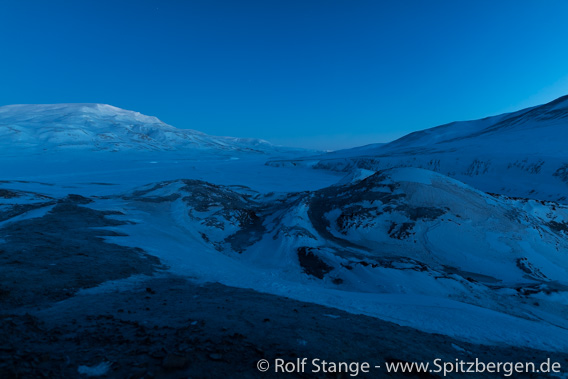
View into Adventdalen during the blue light hour(s).
Soon, however, the blue light gives way to darkness again, the “days” are still short. But the night does always have something to offer. In recent days, northern light activity was a bit limited. Not that there weren’t any at all, but limited, and sometimes you do also have to sleep, so it is inevitable to miss out sometimes. It is all about being in the right time at the right place, and that little bit of luck!
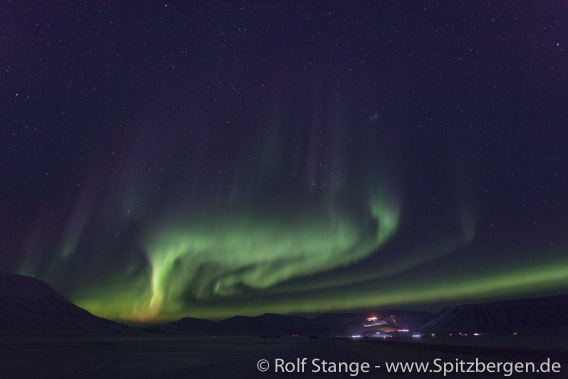
Northern light over Adventdalen (I).
The lights of mine 7 and some huts in the lower right corner.
Today, we were – once again – at the right time in the right place. We just had that bit of luck. Kind of on the way to go shopping. Never leave the house without the camera 🙂

Northern light over Adventdalen (II).
Lunar eclipse over Spitsbergen
Mon
21 Jan
2019
Today (21 January 2019) was the day (well, it is not really a day, the sun does not rise at all here currently) of a major astronomical event, the next one after the solar eclipse in 2015. The lunar eclipse that was visible in Spitsbergen from approximately 6 a.m. was certainly worth setting the alarm clock for.

Today’s lunar eclipse: the “blood moon” over Longyearbyen.
After a short observation of the initial lunar eclipse over Longyearbyen, we went out into Adventdalen to get further away from the big city lights and to get a natural background for the impressive celestial event.

Lunar eclipse over Adventdalen: the “blood mmoon” over Spitsbergen (I).
The duration of the lunar eclipse was much more agreeable than that of the above-mentioned solar eclipse, the total phase of which did not last longer than 2 minutes and a few seconds. This could make the astro-photographers sweat despite of the temperatures around minus 20 degrees (C) back then.
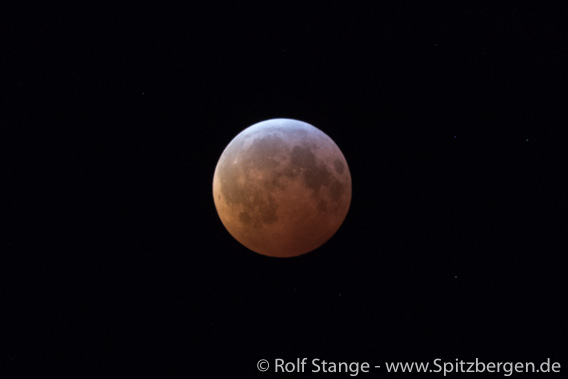
Mondfinsternis im Adventdalen: der “Blutmond” über Spitzbergen (II).
Not that it was any warmer today, but we could take it with time: the total phase of today’s lunar eclipse was nearly an hour long, so next to taking photos, we could just enjoy the event and a sip of hot chocolate – a very good thing considering the temperature. The stars were amazing, they came out bright and strong due to the reduced moonlight. Very impressive!
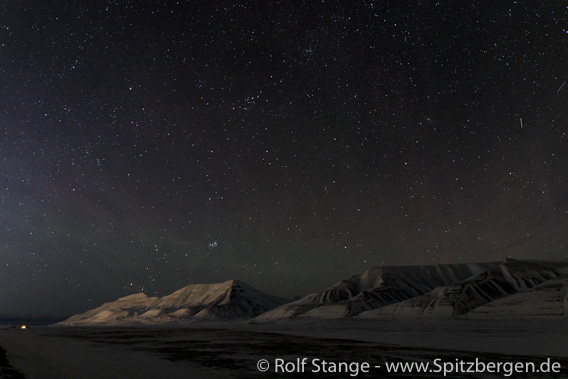
Stars during the lunar eclipse in Adventdalen.
Finally, my current ceterum censeo: I have made a new photo book, focussing on aerial photography and thus showing the Arctic from a very unsual perspective. In theory, the book is in German, but in practice, it does hardly have text. 134 out of 137 pages do just have stunning photos, placenames and a little map. Norwegens arktischer Norden (2) – Aerial Arctic shows Jan Mayen and Svalbard from the air.
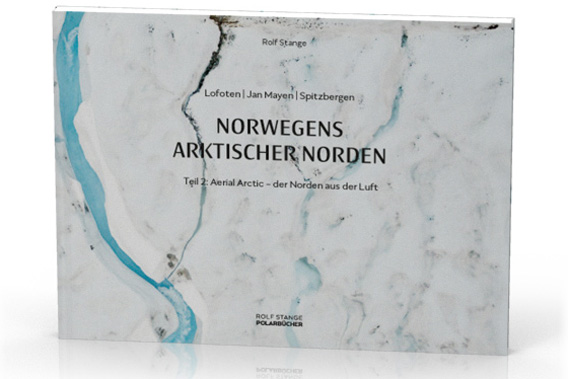
Rolf’s new photo book Norwegens arktischer Norden (2) – Aerial Arctic shows Jan Mayen and Spitsbergen from a new and stunning perspective.
Vinkelstasjon, neighbour reindeer and Science Slam
Sun
20 Jan
2019
Time is flying, there is always something to do. Mostly stuff that isn’t worth mentioning, but it is really filling the days. Everyday life. Projects. Work.
Yes, and life. Friends. Being outside.
Being outside is obviously one main reason for living in Longyearbyen. It will soon be full moon and the sky is mostly clear. The light is pure magic. The Norwegians have a beautiful word for that: “trolsk”. Maybe you can use “trollish” to translate it? It is “magical”, but that does not really hit the nail on the head. With “trolsk”, we don’t associate Harry Potter but rather some kind of fairytale magic with a slight undertone of danger and gloominess. Just like the arctic: of breathtaking beauty, but with a touch of danger lurking somewhere hidden, often not being visible. Trolsk.
Most tours do currently not go anywhere remote. That is not the point now. You will find the whole beauty of the polar night in Longyearbyen’s vicinity. It is of course always an idea to go somewhere without artificial light.
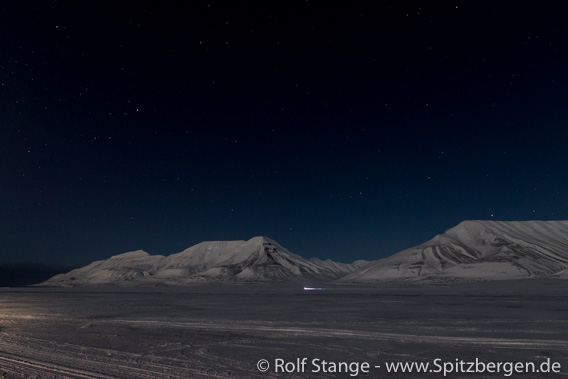
Adventdalen in the polar night.
There is, of course, a lot of artificial light in and near Longyearbyen. Whenever there is a northern light you have to go to a suitable place for undisturbed observation and photography. A bit of artificial light does, of course, not hurt, often it has a charme of its own. Like the Vinkelstasjon in Endalen, which used to be a part of the old coal cableway. Today, it is illuminated during the polar night, providing a lovely eyecatcher in the dark landscape.
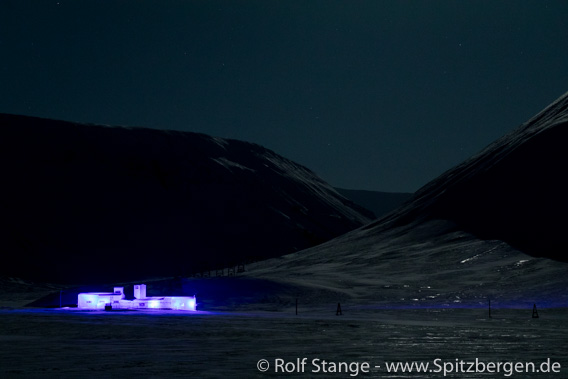
The Vinkelstasjon in Endalen used to be a part of the coal cableway in the past.
Today, it is part of the local history and, in the dark time, a light installation.
It is part of the practical aspects of moving around in the dark that high-vis jackets and reflectors are strongly advised. Otherwise, the risk of being hit by a car is significant and one day it will crash.
The reindeer don’t know that. They tend to stand just next to the road. And the don’t look left or right before they start crossing it.
When you leave the house in the morning and there is a reindeer next to the entrance in the dark, then it can give you a bit of a sudden weak-up. As soon as you realise that the big furry animal just in front of you is actually a reindeer, it is a bit of a relief which feels quite good.
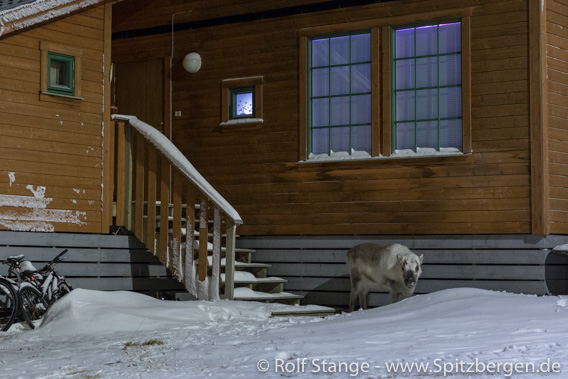
Reindeer in Longyearbyen.
There is a lot going on in Longyearbyen in terms of culture, education and science. In January, there is the Svalbardseminar. Experts of various fields offer presentations to tell the public about their field of knowledge. These presentations are usually in Norwegian, hence not an attraction for international visitors, but if you understand Norwegian, then they are usually very interesting.
This week, there was a “Science Slam” scheduled. Several scientists talked about their work and research results in short lectures which were supposed to be as entertaining as educative. Everything was allowed as long as it is not generally forbidden and nobody is harmed. This worked altogether quite well.
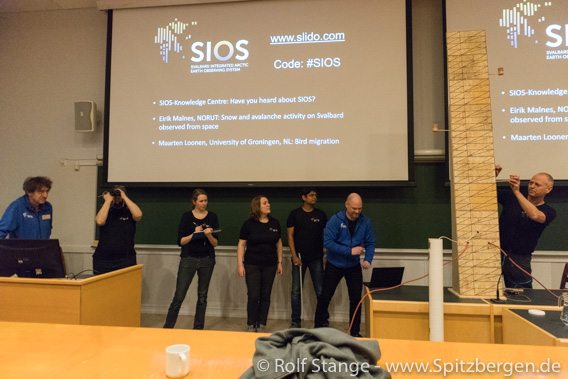
SIOS Svalbard introducing themselves in the Svalbardseminar at UNIS.
In the photo above, SIOS Svalbard (“Svalbard integrated arctic earth observing system”) staff are introducing their organisation, the design and purpose of which is hard to grasp in just a few words. SIOS is kind of a meta-scientific organisation, trying to ensure that efficient collecting and exchange of all sorts of data is working smoothly in practice, beyond borders of different nationalities, projects and fields of science.
And then, there is of course Maarten Loonen, the Dutch specialist for bird migration, arctic geese and tundra. We meet him quite regularly in Ny-Ålesund in the summer, where he has been part of the regular outfit as long as even the oldest ones can remember. In a way that you just can’t imitate, Maarten manages to squeeze a lot of knowledge into a few minutes that is hard to remember – unfortunately, because it is fascinating stuff. Just an example: geese have a completely different digestion system than reindeer. Whatever a geese puts into herself at the front end will leave her again at the rear end after 1-2 hours. Reindeer need much more time for the same process, but they make use of a much higher proportion of the energy and nutrients stored in the plant material that they take up. Which means that what leaves a goose’s butt (my wording, not Maarten’s) is still perfectly good food for a reindeer. But not always, that depends again on what the goose has eaten. And you can actually see it on the colour of the droppings. And so on and so forth. I just can’t recall all of it, unfortunately. If you ever have a chance to listen to Maarten Loonen: go for it!
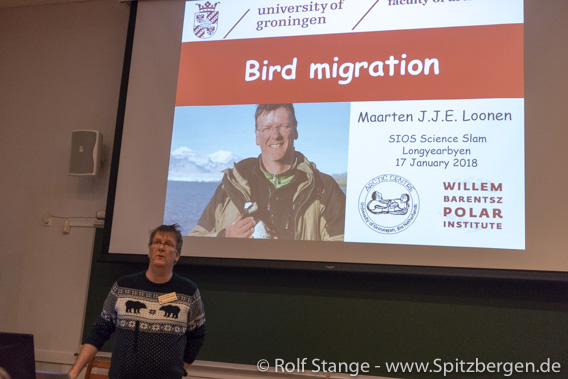
Maarten Loonen talking about arctic migrating birds, mainly geese and their importance for the arctic tundra, in the Svalbardseminar at UNIS.
Finally, my current ceterum censeo: I have made a new photo book, focussing on aerial photography and thus showing the Arctic from a very unsual perspective. In theory, the book is in German, but in practice, it does hardly have text. 134 out of 137 pages do just have stunning photos, placenames and a little map. Norwegens arktischer Norden (2) – Aerial Arctic shows Jan Mayen and Svalbard from the air.

Rolf’s new photo book Norwegens arktischer Norden (2) – Aerial Arctic shows Jan Mayen and Spitsbergen from a new and stunning perspective.
The arctic blog continued: back to Longyearbyen!
Sat
19 Jan
2019
After a winter- and christmas period in our southern home, we return to our northern home: back to Longyearbyen! We spend a few days in Norway on the way up, visiting good friends, before we board the plane in Oslo.
The flight leaves from Oslo Gardermoen in the morning and arrives in Longyearbyen mid-day. We fly away from the sunlight and into the darkness. While climbing up the ladder to the plane, we enjoy a few last moments of sunlight. They will be the last ones for several week.
Gallery flight to Longyearbyen
- gallery anchor link: #gallery_1455
Click on thumbnail to open an enlarged version of the specific photo.
The magic of the polar night is waiting for us!
The moon is waxing – that is not a secret, that is the same everywhere on Earth at the same time. But here, it is more important than elsewhere. Not only because far above the polar circle the moon is hardly seen during the summer, because then it remains largely below the horizon unless it is new moon, when you don’t see it anyway. But now, in winter, the moon is stunning. And it is a very important light source, much more than in latitudes where the sun is more reliable in wintertime.
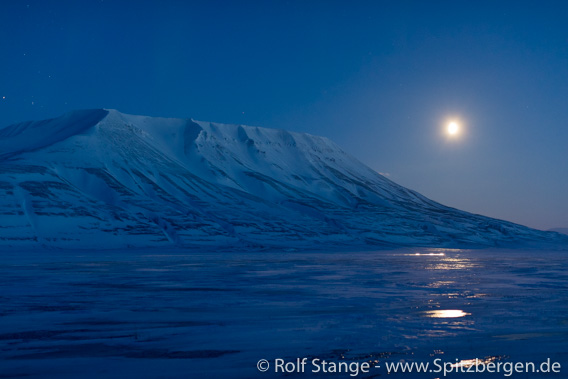
Adventdalen in the polar night (I): the moon is shining over Operafjellet.
The appearance of the country is magical. The moon is casting silver-blue light over the landscape which is covered with a thin layer of snow and ice. On photos, the moon appears very bright so you might even think it is the sun.
Photographing this kind of beauty is a challenge. Most photographs are are far too bright. Of course you can expose your photo until they look as if taken on a sunny day. The results will be beautiful but they don’t have much to do with reality. Reality IS hauntingly beautiful, and it is, well … reality! It doesn’t get much better than that, but it is hard to capture in an image. The beauty that the eye which is accustomed to darkness perceives may just appear as darkness on a reasonably realistic image. And that can also be realistic, but maybe not quite the reality, if that makes sense.

Adventdalen in the polar night (II): a bit darker, a bit more realistic
(? depending on how well your eyes are accustomed to darkness when you are out in the field).
I am trying to find a compromise which is close to reality and delivers the real beauty of the polar night at the same time.
Last but not least for this first entry of my arctic blog 2019 an impression from Longyearbyen in the polar night. A perspective that, I am sure, many of you will know, but possibly in very different light conditions.

High noon in Longyearbyen in polar night. The sundial does currently have some technical problems 😉
Finally, let me mention that I have made a new photo book, focussing on aerial photography and thus showing the Arctic from a very unsual perspective. In theory, the book is in German, but in practice, it does hardly have text. 134 out of 137 pages do just have stunning photos, placenames and a little map.
Norwegens arktischer Norden (2) – Aerial Arctic shows Jan Mayen and Svalbard from the air.

Rolf’s new photo book Norwegens arktischer Norden (2) – Aerial Arctic shows Jan Mayen and Spitsbergen from a new and stunning perspective.
More than 300 tons of diesel recovered from grounded trawler Northguider
Good news from the shrimp trawler “Northguider” that ran aground close to the coast of Nordaustland in northern Hinlopen on 28 December, 2018: more than 300 tons of diesel were successfully recovered until Sunday morning in an operation that took several days. The work was carried out by the Dutch specialised company Ardent Global and the Norwegian coastguard, on the coastguard ship KV Svalbard, as the Norwegian broadcasting company NRK reports.
332 tons of marine diesel oil were secured on KV Svalbard until Sunday morning 5 a.m. Such a huge amount of fuel in a sensitive high arctic environment, during a season when the drift ice can approach quickly or the water can freeze locally at any time, could have created a major environmental disaster.
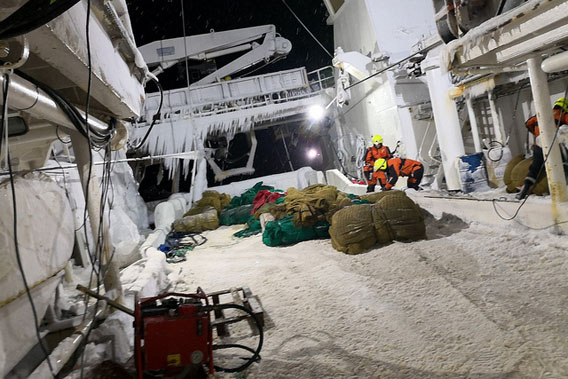
Recovery work at the shrimp trawler Northguider. Photo: Kystverket/Küstenwache.
The operation went faster than expected. The cold, but stable weather conditions of the weekend were an important part in the efficient process to secure the diesel comppletely, and so was the hard work of the Dutch specialists and the crew of the coast guard along with other authorities involved (Sysselmannen, Kystverket).

More than 300 tons of diesel were secured until Sunday morning from the shrimp trawler Northguider, which is grounded in Hinlopen Strait. Photo: Kystverket/Küstenwache.
Smaller amounts of lubrication oil and other chemicals are still being secured, as well as other loose items that may harm or litter the environment.
Salvaging the ship itself is a totally different question. This will be a major operation. How and when this will be done is currently an open question.
The owner of Northguider, Opilio AS, is responsible for coverering the costs.
Tempelfjord accident 2017: monetary penalty
In late April 2017, a serious accident happened in Tempelfjord when a group of snow mobile tourists broke through thin ice. Altogether 7 persons suffered injuries, 6 of them were in the water. 4 of these spent up to 48 minutes in the ice-cold water. One of them died some days later in the hospital in Tromsø.
The deceased was working as a guide for the group, who were Russian tourists. The tour was organised by Arctic Travel Company Grumant, a daughter company of the Trust Arktikugol. The Trust Arktikugol owns and runs Barentsburg and the coal mine there. As employer of the guide and owner of the tour operator, the Trust Arktikugol is legally finally responsible.
Some years ago, the Trust started to develop tourism in Barentsburg to add new economical activities to coal mining, which will obviously not last forever.
In connection to the Tempelfjord accident in 2017, the Arctic Travel Company Grumant and hence the Trust Arktikugol are accused of not having established sufficient safety routines for travelling on sea ice including fjord ice. No ice thickness measurements or other means of establishing sufficient safety margins were taken before the group went out on the ice on the fatal trip in 2017.
Due to the fatal outcome of the accident, which caused 7 persons to end up in ice water and one of them to die later, the state advocate Troms (north Norway) has now imposed a fine of NOK 150,000 (currently ca. Euro 15,300 or US-$ 17,700). The Trust Arktikugol has accepted the fine.
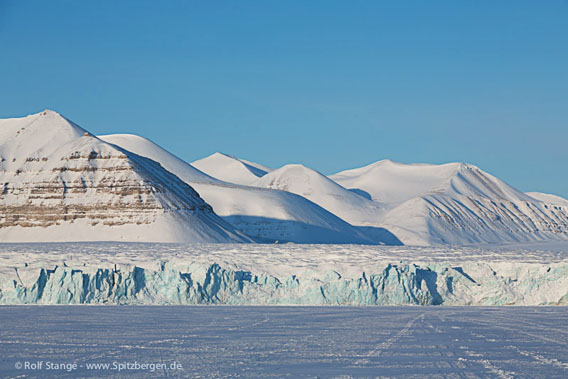
Glacierfront of Tunabreen in Tempelfjord: a popular day trip, but the ice can be dangerous.
The glacier front of Tunabreen in Tempelfjord is the highlight of a popular day trip in the late winter, but the fjord ice is not as reliable anymore as it used to be and the classical route does not always work anymore. In 2018, the ice conditions were good in Tempelfjord, but in the main season the fjord ice was closed by the Sysselmannen for motorised traffic to avoid disturbance of seals and polar bears who were often seen in that area then.
Storm- and avalanche warnings in Longyearbyen
The weather forecast for the next 2 days promises storm and snow for Longyearbyen. The highest wind speeds are expected for Thursday night with velocities up to 26 metres per second (90 km/h or 60 mph, force 10 on the Beaufort scale).
These conditions mean that there will be a very high risk of avalanches.
Public institutions such as schools will remain closed and houses in several areas in Longyearbyen will be evacuated from Thursday 8 a.m. This concerns houses in way 228 and on the west side of the road in Nybyen, according to orders issued by the Sysselmannen. More than 100 persons are concerned by these evacuations.
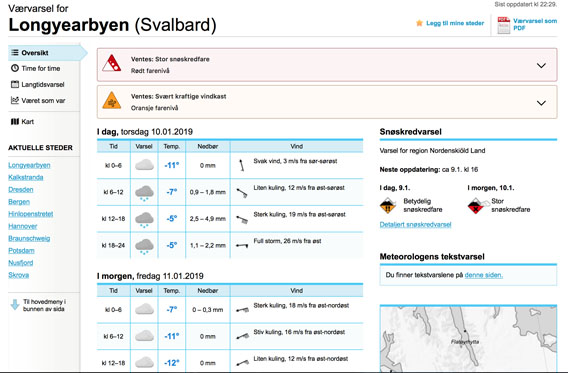
Weather forecast according to yr.no for Longyearbyen: Storm, snow and avalanche risk.
Everybody is requested to take due precautions and to stay away from areas exposed to avalanche risk.
Northguider still grounded in Hinlopenstretet
The trawler Northguider is still sitting on ground at Sparreneset in Hinlopenstretet. Photos taken by Kystverket, the Norwegian maritime authority, show that the position of the ship is very close to the coast of Nordaustland. In this area, the sea bottom is falling steeply from shallow waters down to 400 metres in Hinlopenstretet. It is not yet known how Northguider could get into this position. It is said that there were no technical problems before the accident.
The coast guard ship KV Svalbard has been on site and completed the first phase is work, which was assessing the actual situation of the disabled vessel. After an initial period with weather too bad to go near the grounded ship, specialists of coast guard and Kystverket have been on board Northguider, which is still listing with 15 degrees, but seems to be stable, at least so far. No leakage has be observed so far. Northguider has 300 tons of diesel on board. Many smaller items that have negative environmental potential such as batteries, paint, fishing gear etc. were removed.
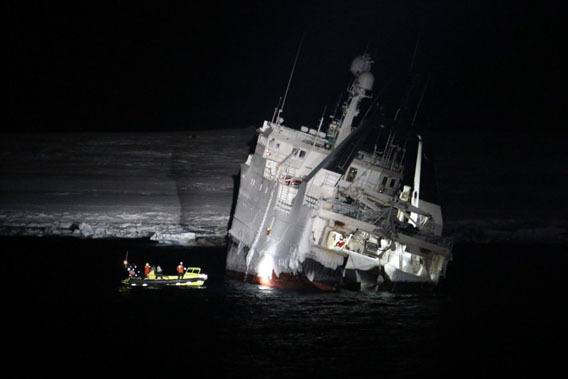
Fishing trawler Northguider grounded in Hinlopenstretet, close to the coast of Nordaustland. Photo: Kystverket.
The investigations also made clear that the ship is too strongly damaged to be pulled of the growned. First, the diesel needs to be removed before an attempt can be made to get Northguider floating again.
KV Svalbard has returned to Longyearbyen to pick up the necessary equipment. The Kystverket assumes that the salvage will take considerable time.
Meanwhile, questions are asked why fishing vessels are allowed to operate in the polar night – or at any time – in areas sensitive enough that even the presence of tourists is seen as a problem by some because they might step on a flower or wake up a sleeping walrus. The grounding site is within the boundaries of the Northeast Svalbard Nature Reserve. Morten Wegede, environmental adviser of the Sysselmannen, said that the situation was very unfortunate and that protection of the environment has highest priority. To ensure this, the Sysselmannen is working closely together with the coast guard, Kystverket, the Norwegian Polar Institute and the owner of Northguider.
Fishing vessel Northguider still on the ground in Hinlopen Strait
All visitors and friends of this website and its author a happy new year! The transition from 2018 to 2019 was calm in Longyearbyen – with some of the usual fireworks, of course. The Sysselmannen just had to step in at a little fight at Huset, other than that New Year’s eve went on peacefully in Spitsbergen.
But the fishing vessel Northguider will keep people busy for some time. Northguider ran aground in Hinlopen Strait last Friday. All 14 crew members could soon be rescued by helicopter, but the ship itself remains just where it hit the ground south of Murchisonfjord. The position of the vessel seems to be stable so far and no diesel or other environmentally dangerous liquids seem to have escaped from the hull, at least as far as can be seen from a helicopter. Nobody has been in the scene so far, the coast guard ship KV Svalbard is expected to arrive there the next days. The first priority will be to remove diesel and other liquids that would damage the environment. The next step will be an assessment whether the ship is able to float so it can be pulled off and towed to Longyearbyen. Northguider’s own engine can not be expected to be functional anymore as seawater has entered the engine room.
Ideally, KV Svalbard can first pump off oil etc. and then tow Northguider to a safe harbour. Whether this will work remains to be seen.
The whole operation may be complicated drastically by ice, in any way it is likely to be a race against time: there is always the risk that the grounded ship slips off and sinks in deeper water. And then there is the ice. Even in times of climate-change-related negative records of arctic sea ice cover and a very slow ice development in the early polar night, the drift ice is now coming from the north and the coastal waters start to freeze over locally, as illustrated by a quick glance at the ice chart.
Just a few weeks ago, all of Svalbard was completely ice-free. But things are currently changing quickly. If Northguider becomes trapped in ice, all further operations would be much more difficult if not impossible. A lot will depend on the weather and currents during the next days and possibly weeks.
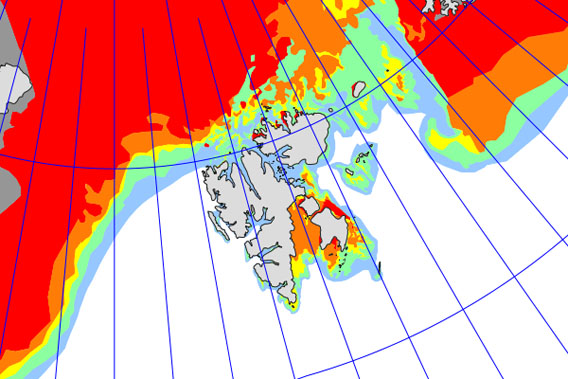
Today’s ice chart from the Norwegian Meteorological Institute: the drift ice is on the way and the fjords are freezing.
Meanwhile politicians in Oslo are starting to ask questions. Shrimp trawling is permitted in deeper waters also in Svalbard’s nature reserves – the site of the Northguide accident is within the boundaries of the Northeast Svalbard Nature Reserve – and trawlers operate in remote areas year-round. The question of the safety of fishing in these areas, far away from harbours and SAR facilities, will receive some new attention now.
News-Listing live generated at 2025/June/15 at 07:10:31 Uhr (GMT+1)


